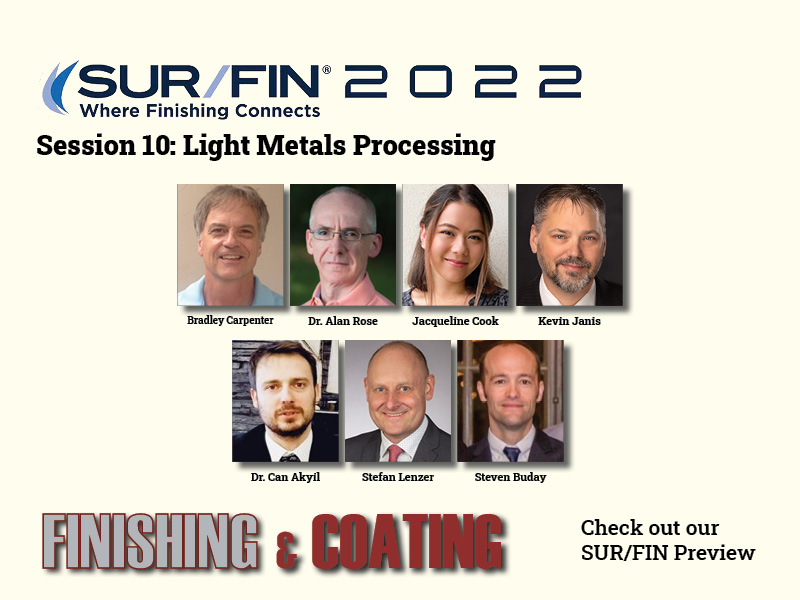Session 10 at the NASF SUR/FIN Technical Conference will be on “Light Metals Processing.”
Here are the abstracts for the presentations on June 8. Please visit www.nasfsurfin.com for information on registering for the event:
Session 10: Light Metals Processing
Session Chairs Rob Pawson, Haviland USA, and Brad Wiley, Rolls Royce
1:30 – 2:00: Development of Coating Process for Photon Collector in Space — Bradley Carpenter, Los Alamos National Laboratory
 Energy in the form of photons are transmitted from objects across eons of time and space. The emptiness of space allows many of these photons to reveal its geographic source, an astronomical fingerprint left from the history of the cosmos. In our relatively crowded solar system, locally generated photons create noise that can alter or mask an astronomical fingerprint. Photon collectors are designed to maximize the signal to noise ratio by filtering stray energy sources from the detector and the surface coating properties have a significant role in whether a photon is absorbed or reflected. A black copper oxide coating has been used for space applications because it forms a textured black film that can trap many of the incident photons, converting them to thermal energy, while others are reflected. The Ebonol-C product has been used since the 1950’s as a copper blackening agent, but has been discontinued by the manufacturer, so we makeup the chemical bath from common laboratory chemicals. In this study, we look at black oxide coating deposition factors on an aluminum substrate that affect the efficiency of the surface coating to absorb incident photons.
Energy in the form of photons are transmitted from objects across eons of time and space. The emptiness of space allows many of these photons to reveal its geographic source, an astronomical fingerprint left from the history of the cosmos. In our relatively crowded solar system, locally generated photons create noise that can alter or mask an astronomical fingerprint. Photon collectors are designed to maximize the signal to noise ratio by filtering stray energy sources from the detector and the surface coating properties have a significant role in whether a photon is absorbed or reflected. A black copper oxide coating has been used for space applications because it forms a textured black film that can trap many of the incident photons, converting them to thermal energy, while others are reflected. The Ebonol-C product has been used since the 1950’s as a copper blackening agent, but has been discontinued by the manufacturer, so we makeup the chemical bath from common laboratory chemicals. In this study, we look at black oxide coating deposition factors on an aluminum substrate that affect the efficiency of the surface coating to absorb incident photons.
2:00 – 2:30: Brush Anodizing for Equipment Repair — Dr. Alan Rose, Corrdesa
 Most aluminum used on aircraft is anodized for corrosion resistance. Over time the anodize layer tends to become damaged, often as a result of overhaul practices intended to remove corrosion from adjacent fasteners. In some cases aluminum not anodized by the OEM suffers in-service corrosion, requiring anodizing at the overhaul level. In other cases aluminum components must be repaired by welding or other methods, leaving the repair area unprotected. Non-drip brush anodizing is a good way to correct these problems, but it is not always easy to carry out in practice, and existing tools are too small to be cost-effective for large areas. We will discuss the use of brush anodizing, its methods and performance in different applications, and how it can be scaled-up to coat much larger areas than we encounter in spot repair.
Most aluminum used on aircraft is anodized for corrosion resistance. Over time the anodize layer tends to become damaged, often as a result of overhaul practices intended to remove corrosion from adjacent fasteners. In some cases aluminum not anodized by the OEM suffers in-service corrosion, requiring anodizing at the overhaul level. In other cases aluminum components must be repaired by welding or other methods, leaving the repair area unprotected. Non-drip brush anodizing is a good way to correct these problems, but it is not always easy to carry out in practice, and existing tools are too small to be cost-effective for large areas. We will discuss the use of brush anodizing, its methods and performance in different applications, and how it can be scaled-up to coat much larger areas than we encounter in spot repair.
2:30 – 3:00: Analysis of Type II Multi-Component Dye Batchs Using Cielab and Reflectance Spectrophotometry — Jacqueline Cook, Reliant Aluminum Products

3:00 – 3:30: The Benefits of Cold Sealing Anodized Aluminum — Kevin Janis, Reliant Aluminum Products
 Cold sealing, also known as room temperature sealing uses nickel fluoride for the sealing reaction. Operating temperatures range from 80 to 90F, with temperature regulation being recommended. Cold sealing has a sealing mechanism that is unique from other seal methods. Good management practices can realize cost and environmental benefits. Cold sealing also affords excellent alkaline resistance. In conjunction with proper anodizing techniques, cold sealing can enhance the lightfastness of dyed anodized articles. Cold sealing meets MIL-A8625 requirements, though other specifications may offer limitations.
Cold sealing, also known as room temperature sealing uses nickel fluoride for the sealing reaction. Operating temperatures range from 80 to 90F, with temperature regulation being recommended. Cold sealing has a sealing mechanism that is unique from other seal methods. Good management practices can realize cost and environmental benefits. Cold sealing also affords excellent alkaline resistance. In conjunction with proper anodizing techniques, cold sealing can enhance the lightfastness of dyed anodized articles. Cold sealing meets MIL-A8625 requirements, though other specifications may offer limitations.
3:30 – 4:00: Novel Approach for Anodizing of Difficult Aluminum Alloys for Higher Sustainability — Dr. Can Akyil, MacDermid Enthone
 The use of high alloyed wrought aluminum parts, including 2XXX or 7XXX series while also including many cast aluminum alloys is currently a trend increasingly being more prominent across many industries. Specifically, for vehicle applications, with a quest for providing E-Mobility options for reduction in weight without loss of strength, the movement to shift from higher weight components to lower weight options is supporting the trend. Although many of these alloys are very capable to meet demands in terms of physical strength versus the weight ratio, in their bare form they are not possible to use due to their low corrosion resistance. Anodizing has long been known as a process to extend the service life and aesthetics of aluminum and aluminum alloy components, however many of their alloying elements of the fore mentioned alloys cause disruptions in the anodizing, coloring and sealing surface finishing processes. The presentation will demonstrate a unique process technology and introduce a novel way of applying a specially designed process to mitigate the negative effects of these alloying materials. It will show how it is possible to achieve minimum anodize thicknesses despite reduced processing times and avoid so called ‘Zero-Spots’. The result of this is a homogeneous anodized layer that exhibits superior corrosion resistance and allows even high silicon cast qualities to be colored with organic dyes. By utilizing the multi stage process principle the productivity and the efficiency of the anodize line will increase significantly causing less scrap hence also lowering the carbon foot print of the line in terms of lowering the energy requirement. Furthermore being able to achieve high quality surface finishes even on high Si cast alloys, automatically opens new applications, helping with the e mobility quest for a more sustainable future.
The use of high alloyed wrought aluminum parts, including 2XXX or 7XXX series while also including many cast aluminum alloys is currently a trend increasingly being more prominent across many industries. Specifically, for vehicle applications, with a quest for providing E-Mobility options for reduction in weight without loss of strength, the movement to shift from higher weight components to lower weight options is supporting the trend. Although many of these alloys are very capable to meet demands in terms of physical strength versus the weight ratio, in their bare form they are not possible to use due to their low corrosion resistance. Anodizing has long been known as a process to extend the service life and aesthetics of aluminum and aluminum alloy components, however many of their alloying elements of the fore mentioned alloys cause disruptions in the anodizing, coloring and sealing surface finishing processes. The presentation will demonstrate a unique process technology and introduce a novel way of applying a specially designed process to mitigate the negative effects of these alloying materials. It will show how it is possible to achieve minimum anodize thicknesses despite reduced processing times and avoid so called ‘Zero-Spots’. The result of this is a homogeneous anodized layer that exhibits superior corrosion resistance and allows even high silicon cast qualities to be colored with organic dyes. By utilizing the multi stage process principle the productivity and the efficiency of the anodize line will increase significantly causing less scrap hence also lowering the carbon foot print of the line in terms of lowering the energy requirement. Furthermore being able to achieve high quality surface finishes even on high Si cast alloys, automatically opens new applications, helping with the e mobility quest for a more sustainable future.
4:00 – 4:30: Surface Finish Options for Light Metals in An EV World — Stefan Lenzer, MacDermid Enthone
 With the increase of popularity of EVs the drive for weight reduction and thus increase in battery range has become one of the hottest topics for automotive OEMs. Light weight construction materials like aluminum and magnesium alloys are key in making future electric vehicles successful by significantly contributing to the car’s efficiency and overall performance. The uses for different aluminum materials in automotive applications are numerous, ranging from decorative components used in interior and exterior applications to brake components exposed to harsh road conditions. Especially ‘newer’ components such as electric housings are undergoing a design process to establish suitable surface finishes. This presentation will discuss areas of application for lightweight materials and surface finish options that are currently available to meet ever increasing demands from automotive OEMs. The challenges for the pretreatment processes are highlighted, depending on the choice of light metal substrate and environment these components are ultimately used in.
With the increase of popularity of EVs the drive for weight reduction and thus increase in battery range has become one of the hottest topics for automotive OEMs. Light weight construction materials like aluminum and magnesium alloys are key in making future electric vehicles successful by significantly contributing to the car’s efficiency and overall performance. The uses for different aluminum materials in automotive applications are numerous, ranging from decorative components used in interior and exterior applications to brake components exposed to harsh road conditions. Especially ‘newer’ components such as electric housings are undergoing a design process to establish suitable surface finishes. This presentation will discuss areas of application for lightweight materials and surface finish options that are currently available to meet ever increasing demands from automotive OEMs. The challenges for the pretreatment processes are highlighted, depending on the choice of light metal substrate and environment these components are ultimately used in.
4:30 – 5:00: Know Your Water: Guide and Improvements to Wastewater Testing and Analysis — Steven Buday, Haviland Products
 All surface finishing operations that discharge treated wastewater are held to federal categorical standards, local limits, and less frequently an NPDES permit. Part of the regulation will be an expectation of sampling and analysis. The frequency and testing required will vary and drives difficulty staying in compliance. Sampling options will be driven by permit and analytical needs. The options can vary between automated composites or grab samples. This presentation will cover types of sampling and analysis that are available or preferred. In addition to testing per permit regulations, regular onsite analysis will give a greater awareness of wastewater treatment performance. However, this will require investment in analytical equipment and the training to be proficient. Equipment selection can range from colorimetric or wet testing to Atomic Adsorption or ICP technologies. Since the cost and complication can vary widely, it is useful to have a guide to selection and will be presented here. Through regular onsite testing, the facility can identify problems with treatment before contaminants are released. This knowledge will also allow one to balance the load of concentrated waste(s) into the treatment system. For example, a plant may want to treat a concentrated zinc tank in wastewater. Through testing, a bleed rate can be dialed in that will allow for successful treatment. This will prevent a potential violation and by treating, will prevent expensive third party hauling of waste. By knowing your water, you can best manage your operations.
All surface finishing operations that discharge treated wastewater are held to federal categorical standards, local limits, and less frequently an NPDES permit. Part of the regulation will be an expectation of sampling and analysis. The frequency and testing required will vary and drives difficulty staying in compliance. Sampling options will be driven by permit and analytical needs. The options can vary between automated composites or grab samples. This presentation will cover types of sampling and analysis that are available or preferred. In addition to testing per permit regulations, regular onsite analysis will give a greater awareness of wastewater treatment performance. However, this will require investment in analytical equipment and the training to be proficient. Equipment selection can range from colorimetric or wet testing to Atomic Adsorption or ICP technologies. Since the cost and complication can vary widely, it is useful to have a guide to selection and will be presented here. Through regular onsite testing, the facility can identify problems with treatment before contaminants are released. This knowledge will also allow one to balance the load of concentrated waste(s) into the treatment system. For example, a plant may want to treat a concentrated zinc tank in wastewater. Through testing, a bleed rate can be dialed in that will allow for successful treatment. This will prevent a potential violation and by treating, will prevent expensive third party hauling of waste. By knowing your water, you can best manage your operations.



































